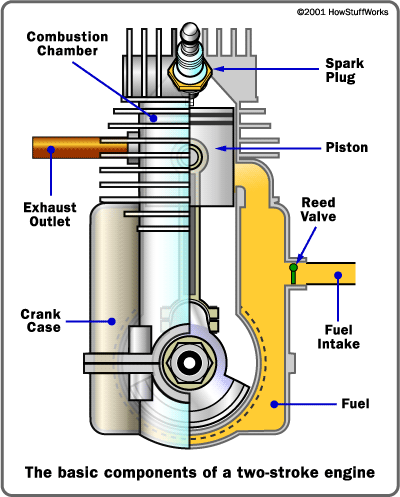The internal combustion engine converts chemical energy into useful
mechanical energy by burning fuel. Chemical energy is released when the fuel-air
mixture is ignited by the spark in the combustion chamber. The gas produced in
this reaction rapidly expands forcing the piston down the cylinder on the power
stroke.
The force is applied typically to pistons, turbine blades, or a nozzle. This force moves the component over a distance, transforming chemical energy into useful mechanical energy. The first commercially successful internal combustion engine was created by Étienne Lenoir.
The piston reciprocates inside the cylinder, exhaust and
intake ports open and close during various stages of the cycle. The movement of
the piston up or down the cylinder makes up one stroke of the four stroke cycle
(Otto cycle). The linear motion is then converted to rotary motion by the
crankshaft. The crankshaft is shaped to balance the pistons which are fired in a
particular order to reduce engine vibration (typically for a 4-cylinder engine,
1-2-4-3 or 1-3-4-2). The flywheel then helps smooth out the linear movement of
the pistons.
The ICE is quite different from external combustion engines, such as steam or Stirling engines,
in which the energy is delivered to a working fluid not consisting of,
mixed with, or contaminated by combustion products. Working fluids can
be air, hot water, pressurized water or even liquid sodium, heated in some kind of boiler. ICEs are usually powered by energy-dense fuels such as gasoline or diesel, liquids derived from fossil fuels. While there are many stationary applications, most ICEs are used in mobile applications and are the dominant power supply for cars, aircraft, and boats.
Types of internal combustion engine
Reciprocating:- Two-stroke engine
- Four-stroke engine (Otto cycle)
- Six-stroke engine
- Diesel engine
- Atkinson cycle
- Miller cycle
- Wankel engine

- Gas turbine
- Jet engine (including turbojet, turbofan, ramjet, Rocket, etc.)
Two-stroke configuration
Engines based on the two-stroke cycle use two strokes (one up, one down) for every power stroke. Since there are no dedicated intake or exhaust strokes, alternative methods must be used to scavenge the cylinders. The most common method in spark-ignition two-strokes is to use the downward motion of the piston to pressurize fresh charge in the crankcase, which is then blown through the cylinder through ports in the cylinder walls.Spark-ignition two-strokes are small and light for their power output and mechanically very simple; however, they are also generally less efficient and more polluting than their four-stroke counterparts. In terms of power per cm³, a two-stroke engine produces comparable power to an equivalent four-stroke engine.
Four-stroke
The steps involved here are:
- Intake stroke: Air and vaporized fuel are drawn in.
- Compression stroke: Fuel vapor and air are compressed and ignited.
- Combustion stroke: Fuel combusts and piston is pushed downwards.
- Exhaust stroke: Exhaust is driven out. During the 1st, 2nd, and 4th stroke the piston is relying on power and the momentum generated by the other pistons. In that case, a four-cylinder engine would be less powerful than a six- or eight-cylinder engine.



No comments:
Post a Comment